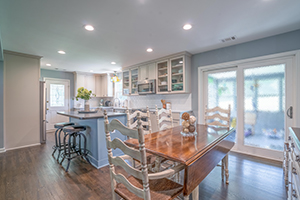
Planning ahead can lead to projects like this beautiful kichen.
Interior design is simple, right? There are so many shows on TV, design websites, and DIY blogs out there; however, this can cause information overload and lead to some serious design mistakes.
Design mistake #1: Not having a plan.
When it comes to design, whether it is a full kitchen reno or a new furniture purchase, it’s always important to have a plan. Know the size of the space you are working with, the function of the space (new or current), and how you want the space to feel, including materials, colors, lighting, etc. This will help narrow down options for you. For example, if you are about to embark on a kitchen remodel and you want the space to feel lighter and brighter, talk with a designer about taking out a wall, adding or enlarging a window, or consider adding a skylight. Also, focus on light colors when it comes to cabinets, countertops, and walls. Start looking at design sites and save pictures of what you like, this will help give you or your designer some guidance as to your style and the feel you are going for. However, once you see several options you like, stop looking or else this can lead to mistake number 2.
Design mistake #2: Info overload.
Design websites and TV shows can be both a blessing and a curse. On one hand, they can provide ideas on what’s trending and popular, but on the other hand, they could provide too many options which oftentimes lead to information overload or, even worse, idea overload. Idea overload means you see so many finishes, fixtures, colors, and styles that you like, but none of them work together. When this happens, your space can end up lacking style and focus, and you end up with a hodge-podge of contrasting ideas. What do you do now? Talk with a designer or decorator to help narrow down exactly what you like and make sure the end style is something that fits both your personality and lifestyle. If you have a lot of ideas that you like, narrow those down to a few concepts or colors that you love and build from there. Try to stick with classic finishes and colors and bring in some trendy colors or ideas as accents. This will help keep your design focused and not looking too trendy.
Design mistake #3: Matchy-matchy spaces.
On the opposite end of mismatched and unfocused design is matchy-matchy design. Coordinating bedroom or living room suites were all the rage in the mid-to-late 20th century. They were easy because they didn’t require much creativity or thought for the buyer. Now, these pieces and other overly matched furniture or design elements will make a house feel dated. Design and decorating are all about carefully curating pieces that fit your style but still work together for an overall theme or feel. Nowadays, it’s OK to mix style periods and elements. Bringing in some old with some new can make a space feel modern, yet classic and cozy at the same time. Think modern furniture with clean lines mixed with a traditional area rug or throw pillows. Curating your space for a layered look adds depth, interest and personality. Really take the time to look around at different shops to find pieces that speak to you, rather than getting everything all from one place.
Design mistake #4: Beautiful, but not functional.
When coming up with a plan for a remodel or decorating, don’t just focus on the look of the space, but also focus on the functionality. A beautiful, yet non-functional, kitchen or bathroom will only cause a lot of regrets later. When designing, spend as much time mentally “using” the space to make sure you are thinking of all the elements that you will need, as the time spent on picking out colors and finishes. Similarly, when it comes to decorating, an all-white living room looks great on TV or in a magazine, but in a home with kids, grandkids, or pets will be a housekeeping nightmare. Always make sure you pick finishes, fabrics and colors that work with your lifestyle.
When it comes to design, there are no fixed rules, but following these guidelines can help keep you from creating a major design headache. Even if you’re not design-minded, with a little help from a trusted friend who follows trends, an interior decorator, or a designer, you can have the home of your dreams. Just remember, oftentimes less is more when it comes to design. Function is as important as style. And don’t forget to incorporate your own personality. Happy decorating!
Photo: courtesy Tracy Tesmer Design/Remodeling




